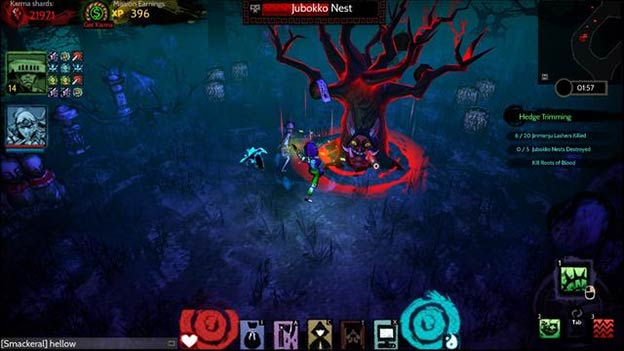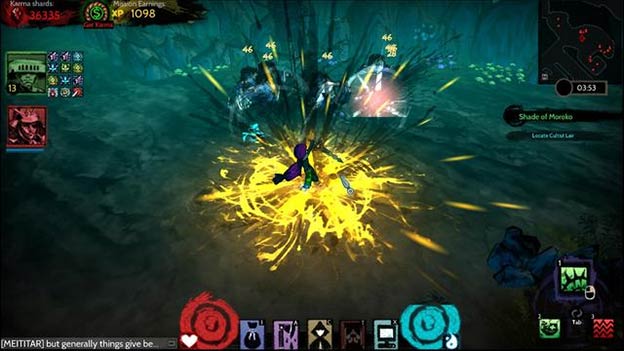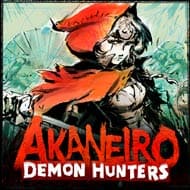Little Red Executioner’s Hood
Oh Akaneiro, you are a strange beast. You tempt us with stunning graphics, drawn from the same Japanese watercolor inspiration as Okami, a perennial artistic favorite. Levels are accompanied by the beatific pluckings of the koto, a string instrument of some prevalence in traditional Japanese music. Your combat mechanics, too, are solid, with the basic framework of an action-RPG given an always-online twist.
It’s a shame, then, that you’re missing the few things needed to turn you into a compelling experience in the long term.
Where Akaneiro falters isn’t in any matter of presentation, as its presentation is positively stunning. Vibrant reds are used in striking contrast to the earth tones that pervade the palette, and empty space has a distinct “grain” to it. Everything is shaded with a heavy touch of “ink,” a fusion between cel-shading and the brushstrokes of Japanese calligraphy. As mentioned before, the audio is also befitting of the game’s tone, with a placid rhythm that evokes the aesthetic beauty of Eastern mythology.

No, Akaneiro’s faults are in the areas of function and motivation, as it is hobbled in the former and almost devoid of the latter.
The materials written about the game claim that it’s inspired by the Red Riding Hood story, twisted to better suit the Japanese aesthetic American McGee and Spicy Horse chose for their latest game. In practice, though, the story seems to be wholly absent from Akaneiro. The gameplay cycle consists of hitting the hub, buying items and abilities for the battles ahead, and then talking to an NPC who sends you out on missions. There are a set number of missions per area and, while they’re often fairly long, they don’t really contain an engaging story. The entirety of the Red Riding Hood connection seems to stem from the use of wolves as enemies and the prevalence of red in the armor one can acquire.
Once one has completed a mission, it’s back to the village with no further ceremony. There is no attempt to chain together a coherent narrative. Just, y’know, proceed to the next mission. Once a mission has been completed, it does unlock a new difficulty tier for that task, but raising or lowering the “threat” level involves using precious karma, unless one simply waits for the threat level to “recharge” over time. It discourages farming missions, since you’ll be met with diminished returns on successive playthroughs, unless you’re willing to invest some currency.

Karma, as it stands, is the universal currency of Akaneiro. Abilities and items are purchased with it, it can be used to revive yourself right where you’ve fallen, the threat level of missions can be changed with it, and rather than being sold, equipment can be transmuted into it. Most importantly, though, it is how one unlocks other parts of the game. Though the starting area and its three missions are immediately available, karma must be spent to unlock the others. This leads to a balancing act that you will inevitably lose, meaning that to continue playing the game with any real efficacy, you must pay real money to Spicy Horse for their “red chilies,” which can be spent to purchase karma.
To clarify, that is a nested, fantasy money purchase. You buy fake money from Spicy Horse with which you then buy fake money specific to this game. The only other red chili purchase in Akaneiro, of which I’m aware, is an immediate unlock for all of the zones. Since unlocking new zones increases your character’s level cap, there is a benefit to doing so even before you’re ready to tackle the toughest missions, but it would be nice to see a system more like Path of Exile’s, in which purchases are exclusively relegated to quality of life enhancements, rather than in-game “boosts” that make your character more powerful. Even the donation incentives are often primarily extra items for use in game: weapons, armor, even pets. While some are surely aesthetic, given that they cost real world money, there’s a certain expectation that they will in some way provide additional in-game benefits, too, which would risk unbalancing most any action RPG.

Of course, that’s less of a concern in Akaneiro than in its competitors because, unlike almost every action-RPG since Diablo launched back in 1996, Akaneiro lacks online multiplayer. It’s on the way (potentially, donations pending), but right now the closest thing to online co-op is the ability to pull other players’ avatars into your game to fight alongside you. It’s a solution, definitely, but it’s less enjoyable than a full-fledged multiplayer component would be. Considering you’re already online and logged into an account, no doubt to facilitate karma purchases and the pseudo-multiplayer the game allows, it’s even stranger that some form of more direct multiplayer was not a core conceit of the game.
Yes, the original Torchlight also lacked multiplayer, in all forms, but it also had systems in place that made advancement inherently engaging. Skill trees, which presented the player with options and tough decisions, diverse weapon drops, and an extensive gallery of enemies to dispatch.

Akaneiro does not have a smooth sense of progression. Missions are isolated endeavors, during which you accrue karma and experience that is not actually yours to use until you complete your task and return to the village. At that point, if you’ve collected enough experience, you gain a level and may opt to focus yourself in Prowess, Fortitude, or Cunning. That’s really all your level brings you, other than the ability to equip level-locked equipment and purchase higher-level abilities. The abilities all cost karma, though, which you also need to progress onto new areas, and the weapons you find aren’t especially varied and magic weapons seem to be exceedingly rare.
The gameplay is still fun, consisting of the same sort of “click to attack, right click for a special ability” stuff that has long since become a genre standard, but characters are graced with three ability wheels, each of which can hold up to three abilities. They can be freely cycled with the tab key, allowing fairly ready access to nine abilities at all times without one’s hand having to wander around the keyboard. Enemy designs are also appealing, and they animate well, though distancing seems to be an issue. Characters tend to swing their melee weapons at the air in front of them and hit others feet away, which looks odd. Coupled with a slight lag on hit-reaction animations (which might be tied to the always-online nature of the game), it just feels a bit off, and lacks weight.
It isn’t that Akaneiro is terrible. It might have been released earlier than it perhaps should have been, lacking gameplay features that would have made its freemium faults less egregious. It also launched in the same window as Path of Exile’s open beta, which has proven surprisingly adept at showing just how far free-to-play can go where quality and playability are concerned . With that in mind, American McGee’s latest comes up wanting.
RATING OUT OF 5 RATING DESCRIPTION 4.5 Graphics
By far the best part of the game, they are gorgeous, drawing obvious inspiration from Japanese watercolor. 3.5 Control
What you would expect from an action RPG, though they sometimes feel imprecise. The variation on the traditional “hotbar” is quite effective, though. 4.0 Music / Sound FX / Voice Acting
Sound effects are satisfying and the sounds of the koto and Japanese reed instruments are both relaxing and enthralling, but there isn’t really any voice work, or plot on which to hang it. 1.5 Play Value
It doesn’t provide a ton of incentive to keep playing. No world to explore, no depths to plumb, just a smattering of missions to be tackled repeatedly at increasingly challenging difficulties./div> 2.2 Overall Rating – Poor
Not an average. See Rating legend below for a final score breakdown.
| Review Rating Legend | |||
|---|---|---|---|
| 0.1 – 1.9 = Avoid | 2.5 – 2.9 = Average | 3.5 – 3.9 = Good | 4.5 – 4.9 = Must Buy |
| 2.0 – 2.4 = Poor | 3.0 – 3.4 = Fair | 4.0 – 4.4 = Great | 5.0 = The Best |
Game Features:
